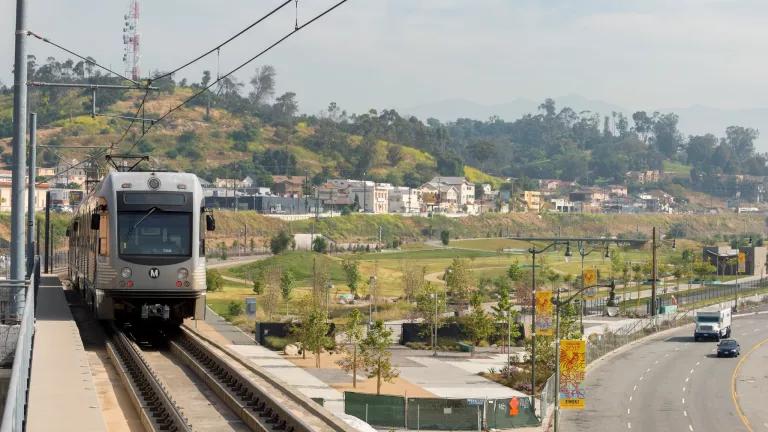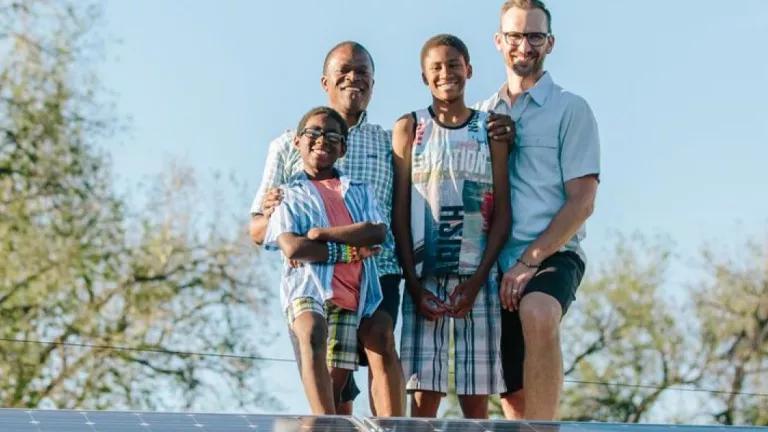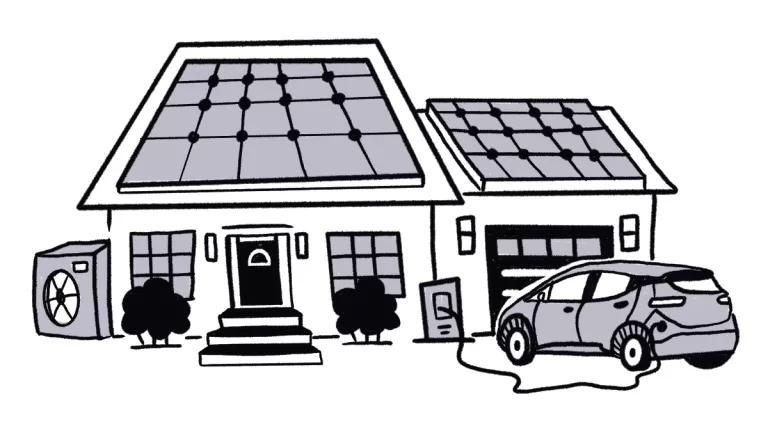Making Good on California's Clean Transportation Promises
Environment, health, and justice groups are looking for the Governor and Legislature to ensure California's transportation investments match its lofty climate goals.

Steve Hymon/Metro Los Angeles, CC BY-NC-SA 4.0
As the dust settles on the 2022 elections across California, we can take stock of where we’ve made progress on tackling the state’s most stubborn source of climate pollution—transportation; namely, the cars and trucks that drive through our communities.
The state has made bold and necessary commitments to zero out gas-burning vehicles by committing to 100 percent zero-emission vehicle sales by 2035. But reaching our climate goals also means helping more Californians get around without having to use polluting vehicles. The California Air Resources Board (CARB), which regulates climate pollution for the state, has found that reaching our climate goals requires both cleaning up vehicles and enabling more people to travel by walking, biking, and public transit rather than driving.
And we must do so in a way that addresses long-standing environmental injustices and creates well-paying jobs. Freeways and shipping continue to disproportionately burden communities with increased pollution and direct displacement from homes and neighborhoods. With billions more transportation dollars flowing to California from the Bipartisan Infrastructure Law, we have no time to waste.
On these fronts, we made some tangible progress in 2022.
- The California legislature passed Assembly Bill 2147 (introduced by Assemblymember Phil Ting), known as the “Freedom to Walk” act, a commonsense reform to traffic law that reduces the likelihood that walkers will get ticketed for jaywalking infractions that disproportionately impact people of color.
- With Senate Bill 922 (by State Senator Scott Wiener), the legislature streamlined environmentally beneficial transportation projects, such as bike- and bus-only lanes.
- The legislature passed bills to streamline infill housing and remove harmful parking requirements.
- Governor Gavin Newsom allocated $1.1 billion in new funding for the state’s Active Transportation Program, which funds local bike and pedestrian projects. It was an important down payment on an overall $2 billion investment need in local bike/ped projects.
- The governor continued to appoint climate and equity champions to the California Transportation Commission (CTC).
- The CTC established a new Interagency Equity Advisory Committee.
- Voters rejected two badly misguided local transportation ballot measures in Fresno and Sacramento counties, showing the public rejects a highway-centric approach to mobility.
But in several other priority areas for reform, the legislature and governor failed to rise to the moment.
- Despite broad support from environmental, transportation, and environmental justice groups, the governor vetoed AB 2438 (by Assemblymember Laura Friedman), which would have codified into state law the requirement to connect our transportation investments with our climate goals.
- The governor vetoed AB 1919 (by Assemblymember Chris Holden) to create a free youth transit pass program.
- Voters unfortunately rejected Proposition 30, which would have delivered $100 billion investment in electric-vehicle and zero-emission transportation options.
- The legislature failed to pass two key bills to ensure communities benefit from our infrastructure investments: AB 1778 (by Assemblymember Cristina Garcia) would have banned the use of state funding and resources to build or expand freeways in communities already burdened by pollution and public health impacts; AB 2419 (by Assemblymember Isaac Bryan) would have required that a minimum of 40 percent of federal infrastructure funds coming to California from the Bipartisan Infrastructure Law be prioritized in communities of color that have been overlooked or harmed by past infrastructure choices.
What does the work look like in 2023 and beyond? At its core, it’s about putting our funding priorities where our climate and equity values are.
Despite some progress to align our transportation investments with our climate goals—through laws like SB 375 and SB 743—state and local governments continue to spend billions on harmful and counterproductive highway projects.
Bigger, wider highways cause more air pollution while failing to deliver congestion relief. We need the legislature and governor to prioritize funding and projects that cut greenhouse gas emissions, connect communities, and support healthy places. And we also need to deprioritize and eventually zero out investments that encourage more driving, undermine our transit services, and push more sprawl development.
Here are some key measures we hope to see next year:
- Legislation that enshrines Justice40 principles in our infrastructure investments.
- Legislation that puts sustainable transportation projects like rail lines, electric bus fleets, and bike networks at the front of the line for priority and funding.
- Legislation that builds on AB 1778 (Garcia) by protecting communities from the harmful impact of highways.
- State budget support for public transit agencies that are still recovering ridership and about to run out of major COVID-19 relief funding from the federal government, which could lead to service cuts or higher fares. Investments are needed in operating funding as well as rider- and equity-focused improvements that can help agencies restore and grow ridership, such as free fares for youth.
- Maintaining budget support for active transportation investments that are needed to reach our climate goals and deliver community-supported projects.
Such reforms, taken together with our progress to date, will ensure that California remains a leader in equitable transportation and climate action.





